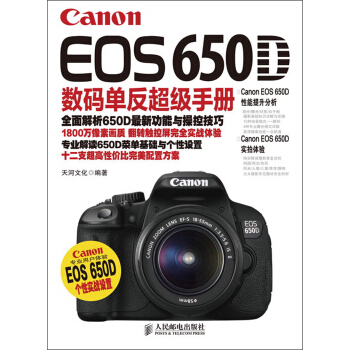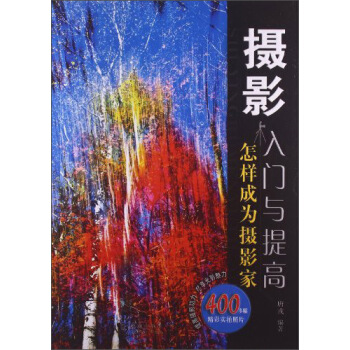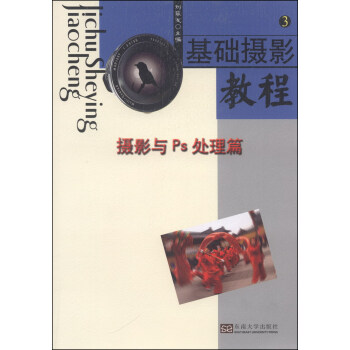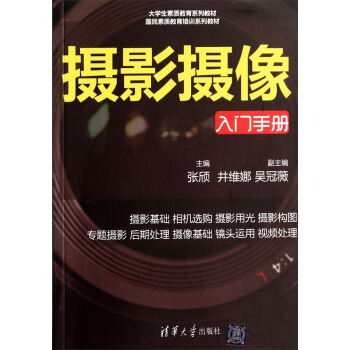

具体描述
内容简介
《Canon EOS 650D数码单反超级手册》全面介绍了Canon EOS 650D的各项使用功能,并且由浅入深地讲解了相机的基本使用技巧和相机菜单的专家级设定,《Canon EOS 650D数码单反超级手册》根据目前摄影爱好者的需要,对于基础摄影知识、镜头与附件的选择、视频拍摄技术、不同题材的拍摄以及数码图片后期技巧进行了详细地解读。《Canon EOS 650D数码单反超级手册》适合Canon EOS 650D用户以及摄影爱好者学习参考。
目录
1 初识Canon EOS 650DCanon EOS 650D的8大改进之处
轻巧流畅的机身设计
可旋转式触控液晶监视器
约1800万有效像素的新型CMOS图像感应器
高性能的DIGIC 5数字影像处理器
最高约5张/秒的高速连拍
高达25600的感光度和高效的降噪功能
中央八向双十字全9点十字型自动对焦
专业级的短片拍摄
Canon EOS 650D机身功能介绍
机身正面功能详解
机身背面功能详解
机身顶面功能详解
机身底面功能详解
机身右侧面功能详解
机身左侧面功能详解
取景器界面
拍摄菜单界面
速控屏幕界面
2 使用Canon EOS 650D拍摄属于自己的照片
拍摄第一张属于自己的照片
使相机更完整——安装镜头
存储所拍摄的图像——为相机装入存储卡
让相机工作起来——为相机装上电池
看清取景器画面——调整屈光度
获得清晰的画面——自动对焦
设定曝光模式——场景智能自动模式
对焦所要拍摄的画面——半按快门
清脆的快门声——完成拍摄
根据不同的题材选择合适的情景模式
Canon EOS 650D模式轮盘简介
1.场景智能自动模式
2.闪光灯关闭模式
3.创意自动模式
4.人像模式
5.风光模式
6.微距模式
7.运动模式
8.夜景人像模式
9.手持夜景模式
10.HDR逆光控制模式
3 对Canon EOS 650D菜单进行专家级设定
拍摄菜单——拍摄前对相机进行的设定
1.图像画质
2.镜头像差校正
3.减轻红眼 开/关
4.自动亮度优化
5.色彩空间
6.照片风格
7.除尘数据
实时拍摄菜单——对实时显示拍摄的设定
1.实时显示拍摄
2.自动对焦方式
3.连续自动对焦
4.触摸快门
5.显示网格线
6.长宽比
7.测光定时器
播放菜单——管理和查看拍摄后的照片
1.保护图像
2.旋转图像
3.删除图像
4.显示柱状图
设定菜单——让相机更适合自己
1.选择文件夹
2.自动旋转
3.自动关闭电源
4.液晶屏自动关闭
5.屏幕色彩
6.清洁感应器
7.自定义功能(C.Fn)
8.固件版本
我的菜单设置——快捷设置自己常用的菜单
1.注册到我的菜单
2.排序
3.删除项目
4.删除全部项目
5.从我的菜单显示
4 详解使用Canon EOS 650D所需要的摄影技术
掌握Canon EOS 650D的对焦功能
对焦方式的选择——自动对焦与手动对焦
Canon EOS 650D的对焦点设定
根据不同的场景选择合适的自动对焦方式
实拍中对焦位置的选择
练习使用光圈
什么是光圈
恒定光圈与非恒定光圈——牛头与狗头
光圈的作用
光圈与景深
选择合适的光圈拍摄优美的画面
练习使用快门
认识快门
快门的作用
选择合适的快门速度拍摄照片
利用Canon EOS 650D的B门拍摄夜景
练习使用ISO感光度
感光度的概念
Canon EOS 650D的感光度功能设定
感光度与画质——噪点是如何产生的
Canon EOS 650D的降噪功能
在不同的环境中选择合适的感光度
利用白平衡控制照片色彩
色温与白平衡
Canon EOS 650D不同的白平衡模式下的色彩表现
利用Canon EOS 650D的自定义白平衡准确还原场景色彩
Canon EOS 650D的白平衡偏移/包围功能
在拍摄时选择合适的白平衡模式
练习测光与曝光
认识曝光
Canon EOS 650D的曝光补偿和包围曝光
白加黑减是什么意思
学会看直方图控制曝光
掌握测光原理
Canon EOS 650D的4种测光模式
利用灰卡测光实现完美曝光
5 Canon EOS 650D高手进阶拍摄和短片拍摄
M手动曝光模式——完全由摄影者决定的曝光模式
Av光圈优先自动曝光模式——最常用的曝光模式
Tv快门优先自动曝光模式——掌握画面动静
P程序自动曝光模式——简单快捷的创意拍摄模式
实时显示拍摄
正确认识并使用Canon EOS 650D的全高清摄像功能
Canon EOS 650D的全高清摄像功能
自动曝光拍摄
手动曝光拍摄
拍摄影片时拍摄单张照片
影片的存储和回放
使用电视机观看拍摄的高清短片
6 镜头知识与配置
镜头基础知识
佳能镜头名称解读
佳能镜头结构图解读
MTF(镜头性能测试)图解读
镜头的焦距与拍摄视角
定焦镜头与变焦镜头
广角镜头、标准镜头与长焦镜头
4款经济实用的EF-S镜头
Canon EF-S 18-55mm f/3.5-5.6 IS II
Canon EF-S 15-85mm f/3.5-5.6 IS USM
Canon EF-S 18-135mm f/3.5-5.6 IS STM
Canon EF-S 18-200mm f/3.5-5.6 IS
6款高质量的EF镜头
Canon EF 16-35mm f/2.8L II USM
Canon EF 24-70mm f/2.8L II USM
Canon EF 70-200mm f/2.8L II IS USM
Canon EF 17-40mm f/4L USM
Canon EF 24-105mm f/4L IS USM
Canon EF 70-200mm f/4L IS USM
2款常见的定焦镜头
Canon EF 50mm f/1.8 II
Canon EF 100mm f/2.8L IS USM微距
7 为Canon EOS 650D选择合适的附件
三脚架
快门线
摄影包
滤镜
滤镜是什么
UV滤镜的使用方法
偏振镜的使用方法
渐变滤镜的使用方法
滤镜的选择方法
存储卡
防潮箱
遮光罩
黑卡、灰卡和白卡
8 拍摄前一定要掌握的摄影理论
镜头与透视
什么是影调层次
什么是透视
镜头与透视的关系
学会构图
认识摄影构图
构图与构图元素解析
点线面在构图中的作用
黄金构图
几何构图
在拍摄中进行合理的构图
理解光影
光线的软硬会影响照片的质量
合理地利用不同方向的光
利用不同的光可以塑造不同的画面情感
利用Canon EOS 650D拍摄美丽的剪影
把握色彩
色彩的三要素——色相、明度和饱和度
不同色彩之间的搭配
不同色彩的情感表现
9 实战:利用Canon EOS 650D拍摄不同题材的照片
风光摄影
拍摄前对相机进行的设置
镜头和附件的选择
风光摄影规律:寻找合适的对焦点
风光摄影规律:寻找合适的景物作为前景
风光摄影规律:地平线要平
山景:利用太阳表现山脊的线条
山景:利用斜射光勾勒山体的轮廓
山景:山间云海的梦幻感觉
水景:拍摄水景时的曝光控制
水景:拍摄海洋时的构图和取景技巧
水景:平静无风的湖面拍摄岸边景物的倒影
林木:拍摄林木时的光影和色彩的魅力
林木:大面积林木的拍摄技巧
春季:花卉最能表现出生机与活力
夏季:浓郁的画面要注意层次调节
秋季:最容易拍摄出漂亮的风光画面
冬季:拍摄雪景的技巧
小技巧让照片生动起来
人像摄影
选择合适的镜头
人像摄影规律:尽可能地突出人物
人像摄影规律:对焦点放在眼睛上
人像摄影规律:不要切割关节
人像构图:特写人像
人像构图:半身人像
人像构图:七分人像
人像构图:全身人像
人像构图:三分法人像构图
人像构图:几何法人像构图
人像构图:黄金分割法人像构图
人像用光:顺光人像摄影
人像用光:逆光人像摄影
人像用光:斜射光人像摄影
拍摄人像的最佳时间
儿童摄影
一定不要使用闪光灯
尽量调动儿童的情绪
注意抓拍和偷拍
体育摄影
设定Canon EOS 650D相机的连拍功能拍摄运动中的对象
使用快门提前量才能抓住更精彩的瞬间
体育摄影构图
商品与静物摄影
商品与静物的静态表现
拍摄商品与静物时的构图与色彩选择
商品与静物摄影用光技法
结合具体用途拍摄商品
10 数码后期门与实践
DPP使用入门
认识RAW格式
批量转换RAW格式图像
常用的Photoshop工具
调整画面明暗:“色阶”调整
调整画面明暗:“曲线”调整
调整画面色彩:“色相/饱和度”调整
调整画面色彩:“黑白”调整
调整画面色彩:“照片滤镜”调整
调整画面色彩:“通道混合器”调整
“锐化”工具——让照片更清晰
“模糊”工具——消除噪点或制作模糊效果
“液化”工具——改变人物脸型与体型
“修复”工具——修补照片的斑痕与瑕疵
……
前言/序言
用户评价
我之前一直认为,数码单反相机的使用门槛很高,尤其是像Canon EOS 650D这样的专业级设备,更是让我望而却步。直到我无意中翻阅了这本《Canon EOS 650D数码单反超级手册》,我才发现,原来摄影的乐趣可以如此触手可及。这本书的语言风格非常亲切,就像一位经验丰富的摄影师在手把手地教你一样,没有晦涩难懂的专业术语,即使是我这样的新手,也能毫不费力地理解其中的奥秘。它非常细致地讲解了相机上的每一个按键和拨盘的功能,甚至连菜单选项中的每一个细微设置,都进行了详细的解释和应用场景的说明,让我觉得我的相机不再是一个冰冷的机器,而是我手中一个充满无限可能的创作工具。最让我着迷的是,书中专门辟出了一个章节讲解“如何拍摄出具有视觉冲击力的照片”。它不仅仅停留在理论层面,而是通过大量的对比图和案例分析,让我清晰地看到了不同的拍摄手法和设置对照片效果的影响。比如,它详细讲解了如何运用“黄金分割点”来安排画面主体,如何通过“引导线”将观众的视线引入画面深处,以及如何利用“对称构图”来营造画面的稳定感和庄重感。这些技巧的运用,让我的照片瞬间提升了一个档次,变得更加耐看和有吸引力。我还学会了如何根据不同的拍摄对象,如风光、人像、静物等,选择最合适的拍摄模式和参数设置,让我在各种场景下都能拍出令人满意的作品。这本书不仅仅是教会了我如何操作相机,更是点燃了我对摄影的浓厚兴趣,让我渴望去捕捉生活中的每一个美好瞬间。
评分天呐,我简直不敢相信我花了多少时间在研究我的650D上,直到我发现了这本《Canon EOS 650D数码单反超级手册》。说实话,一开始我只是觉得它的名字听起来很“专业”,想着也许能帮我解决一些基本的拍摄难题,但它带来的惊喜远远超出了我的预期。我是一个比较喜欢“动手”学习的人,但很多时候,理论知识的缺乏让我感觉像是在原地打转。这本手册就像是我迷雾中的灯塔,它并没有直接告诉我“怎么拍出好照片”,而是循序渐进地讲解了EOS 650D这款相机背后蕴含的原理。从光圈、快门速度、ISO的相互作用,到白平衡的细微调整如何影响画面的色彩倾向,再到测光模式的各种选择在不同场景下的应用,这些我之前听过的概念,在这本书里被拆解得淋漓尽致,配上图文并茂的解释,让我茅塞顿开。我特别喜欢它讲解景深的那一部分,以前我总以为景深就是“背景虚化”那么简单,但手册里详细解释了焦距、光圈大小和拍摄距离对景深的影响,甚至还给出了几个非常实用的实用技巧,比如如何利用大光圈来突出主体,或者在拍摄风景时如何最大化景深让整个画面都清晰锐利。我曾经因为不理解测光模式,拍出来的照片要么过曝要么欠曝,但现在我能够根据不同的拍摄对象和光线条件,灵活选择评价测光、中央重点测光和点测光,并且知道什么时候需要使用曝光补偿。更不用说它对自动对焦系统的深入剖析了,以前我总是依赖相机的自动对焦,但手册里讲解了不同的自动对焦点选择方式,以及如何利用连续自动对焦和单次自动对焦来应对运动物体和静止主体,这让我感觉我的相机终于被我“驯服”了。
评分I’ll admit, I was a bit overwhelmed when I first got my Canon EOS 650D. It’s a powerful camera, but all the buttons and settings felt daunting. I searched for a guide that would demystify it for me, and that’s when I stumbled upon this "Canon EOS 650D Digital SLR Super Manual." It’s been an absolute lifesaver. What I love most about this book is its practical approach. It doesn't just list features; it explains how and why you should use them. For instance, the section on understanding and utilizing the different metering modes was a game-changer. Before reading this, I was largely clueless about evaluative, center-weighted, and spot metering. Now, I understand how each mode functions and can confidently choose the appropriate one for various shooting situations, leading to consistently better exposed images. The book also does an excellent job of explaining the nuances of depth of field. It breaks down how aperture, focal length, and distance all play a role in creating that beautiful background blur or ensuring everything in the frame is sharp. I've been experimenting with it, and the results are stunning – I can finally control how much of my subject is in focus and how much of the background recedes. Beyond the technical aspects, the manual also offers invaluable advice on composition and visual storytelling. It delves into concepts like leading lines, framing, and the rule of thirds, but it goes further by showing how these principles can be used to create a more compelling narrative within a photograph. I've found myself looking at scenes differently, actively seeking out opportunities to apply these compositional techniques. It has truly elevated my photography from simply capturing an image to creating a visual story. The detailed explanations on flash photography and its creative applications, including bouncing the flash and using diffusers, has also been incredibly helpful in improving my indoor and low-light shots.
评分我一直以为自己算是 pretty hands-on when it comes to photography, but diving into my Canon EOS 650D often felt like navigating a dense jungle without a map. That’s where this "Canon EOS 650D Digital SLR Super Manual" came in, and honestly, it’s been nothing short of a revelation. It’s not just a dry technical manual; it’s like having a seasoned photographer patiently guiding you through every dial and menu option. I was particularly struck by the chapter on understanding light. Before, I’d just point and shoot, hoping for the best. Now, I’m starting to see light – how it falls, how it shapes subjects, and how to use it to my advantage. The explanations on different types of light (hard light, soft light, directional light) and how they impact the mood and texture of a photograph were incredibly insightful. It’s also demystified the whole creative exposure triangle for me. I used to get so frustrated with over- or underexposed shots, but the book breaks down the interplay between aperture, shutter speed, and ISO in a way that makes intuitive sense. I can now confidently adjust these settings to achieve specific effects, whether it’s freezing action with a fast shutter speed or creating that dreamy background blur with a wide aperture. And don't even get me started on the section about composition. It goes beyond the basic "rule of thirds" and delves into leading lines, framing, negative space, and balance, providing practical examples that actually make you look at your surroundings differently. I've already noticed a significant improvement in the visual impact of my photos just by applying some of these compositional principles. It’s the kind of book that doesn’t just teach you what to do, but why you’re doing it, which is crucial for developing a personal photographic style.
评分My journey with the Canon EOS 650D had been a somewhat solitary one, filled with trial and error, and a healthy dose of frustration. I'd fumble through menus, randomly adjust settings, and hope for the best. This "Canon EOS 650D Digital SLR Super Manual" changed everything. It's not just a manual; it's a comprehensive guide that addresses the practical challenges and creative aspirations of an amateur photographer like myself. The section on understanding focal length and its impact on perspective was eye-opening. I used to think all lenses were pretty much the same, but the book meticulously explains how different focal lengths can dramatically alter the feeling of a scene – how wide-angle lenses can exaggerate space and depth, while telephoto lenses compress it, bringing distant subjects closer and creating a sense of intimacy. This understanding has completely transformed how I approach framing my shots. Moreover, the detailed breakdown of various shooting modes, beyond just the "Auto" and "Program" settings, has been a revelation. I've moved beyond relying on presets and am now actively experimenting with Aperture Priority, Shutter Priority, and Manual mode. The book provides clear guidance on when and why to use each mode, along with practical examples that illustrate their benefits. I particularly appreciated the emphasis on understanding the "why" behind each setting. It’s not just about telling you what button to press, but explaining the underlying principles that govern image creation. This deeper understanding has empowered me to make more informed decisions and to consciously control the outcome of my photographs. The chapter on understanding the role of different file formats, like JPEG versus RAW, and the implications for post-processing, has also been incredibly beneficial, allowing me to explore the full potential of my images without fear of degrading their quality.
评分我本来是个对相机操作一知半解的人,买了佳能EOS 650D之后,更多的是把它当作一个高级的“傻瓜机”来用。但随着我越来越想拍出一些更具个性和艺术感的照片,我意识到我需要一个能够引导我的工具。这本《Canon EOS 650D数码单反超级手册》就是我找到的那个“宝藏”。它最让我欣赏的一点是,它并没有把所有的知识点都堆砌在一起,而是非常有条理地将内容进行了划分,从最基础的相机功能介绍,到进阶的拍摄技巧,再到一些非常实用的场景应用,循序渐进,让我这种新手也能轻松跟上。我特别喜欢它关于“景深控制”的讲解,以前我总觉得背景虚化是专业相机才能做到的,或者需要昂贵的定焦镜头,但这本书通过详尽的图示和数据分析,让我明白了如何通过调整光圈、焦距和拍摄距离,即使使用套机镜头,也能拍出具有艺术感的景深效果。我尝试按照书中的方法去实践,效果真的非常显著,能够有效地突出主体,让照片的重点更加明确。另一个让我印象深刻的部分是关于“动态抓拍的技巧”。我经常想捕捉孩子玩耍、动物奔跑的瞬间,但总是拍虚。这本书里详细讲解了如何设置相机的连拍模式、选择合适的快门速度,以及如何预判运动方向来进行对焦,让我感觉我终于掌握了“定格瞬间”的秘诀,拍出来的照片清晰而富有动感,记录下了那些珍贵的瞬间。它还介绍了一些关于“利用反光板和柔光板进行拍摄”的小技巧,让我觉得即使在光线不理想的情况下,也能拍出高质量的照片。
评分I was at a bit of a crossroads with my photography. I had my Canon EOS 650D, a decent camera by all accounts, but my photos felt… static. They were technically okay, I guess, but they lacked that spark, that certain oomph that makes you stop and really look. I picked up this "Canon EOS 650D Digital SLR Super Manual" with moderate expectations, hoping for some quick tips and tricks. What I got was a complete paradigm shift in how I approach photography. The manual doesn't just spoon-feed you settings; it encourages you to think critically about every aspect of an image. The section on understanding the histogram, for instance, was a game-changer. I used to gloss over it, but the book explains how to read it not just as a graph of tones, but as a tool to diagnose exposure issues and optimize dynamic range. It’s helped me understand why some of my shots look flat and how to achieve richer colors and better detail in both the highlights and shadows. The detailed explanation of different metering modes and their specific applications in various lighting scenarios has been invaluable. I no longer feel like I’m blindly trusting the camera’s judgment. I can now confidently choose between evaluative, center-weighted, and spot metering based on the scene, leading to far more consistent and pleasing exposures. Furthermore, the deep dive into the nuances of white balance has elevated my color rendition. Before, I’d just leave it on auto and hope for the best, but now I understand how crucial it is to set it correctly to capture accurate colors, whether I'm shooting in tungsten light, fluorescent light, or under the golden hour sun. It’s also opened my eyes to the creative potential of different white balance presets and custom white balance.
评分说实话,我拿到这本书《Canon EOS 650D数码单反超级手册》的时候,并没有抱有多大的期望,我总觉得这种“手册”类的书籍,内容会比较枯燥乏味,充斥着大量的技术术语,对于我这种平时只喜欢随手拍拍的摄影爱好者来说,可能有点太“硬核”了。然而,事实证明,我的担忧完全是多余的。这本书的叙述方式非常灵活,它并没有一开始就抛出大量的技术参数,而是从摄影最基本、也是最吸引人的几个方面入手。我特别喜欢它关于“捕捉决定性瞬间”的论述,它不是那种空泛的理论,而是通过大量的实际拍摄案例,分析了如何在街头、在旅行中,甚至是日常生活中,抓住那些转瞬即逝的美好画面。它教会了我如何观察,如何预判,如何调整相机参数以应对突发情况,让我觉得摄影不再是等待,而是一种主动的探索和发现。关于“构图艺术”的部分,也给我带来了极大的启发。它不仅仅讲解了三分法、对称构图等基础原则,更深入地探讨了如何运用引导线、框架、留白等手法来增强画面的视觉冲击力和叙事感。我曾经觉得我的照片看起来总是不够“专业”,不够吸引人,但自从我开始运用书里介绍的构图技巧,我的照片立刻变得更有层次感和故事性,甚至有朋友看了我的照片,以为我报了什么高级摄影班。这本书还很贴心地介绍了一些关于“后期处理的基础知识”,让我明白,好的照片不仅仅是拍摄出来,更是在后期的精心雕琢中得以升华。它并没有要求我成为一个PS大师,而是教会了我如何通过简单的调整,让照片的光影、色彩和细节更加完美,从而更好地传达我想要表达的情感。
评分Honestly, I approached this "Canon EOS 650D Digital SLR Super Manual" with a healthy dose of skepticism. Many photography books, especially those focused on specific camera models, tend to be either overly technical or disappointingly superficial. This book, however, managed to strike a perfect balance. It doesn't assume you're a seasoned pro, nor does it patronize you with overly simplistic explanations. Instead, it takes you on a journey of discovery, gradually revealing the power and potential of your Canon EOS 650D. The section on understanding the different autofocus modes and their specific applications was a revelation. I used to rely heavily on the center AF point, often missing crucial moments. The book meticulously explains the advantages of single-point AF, dynamic area AF, and auto-selection AF, providing real-world scenarios where each excels. This has significantly improved my hit rate when photographing subjects in motion, from fast-paced sports to candid portraits. Furthermore, the comprehensive guide to understanding different lens types and their unique characteristics has been instrumental in expanding my creative horizons. I’ve learned how to choose the right lens for the right job, understanding the impact of focal length, aperture, and optical quality on the final image. The advice on selecting prime lenses for their sharpness and wide apertures, as well as zoom lenses for their versatility, has been incredibly practical. It's also guided me on how to best utilize my existing kit lens, pushing its capabilities to their limits. The book’s emphasis on creative storytelling through photography, rather than just technical execution, is what truly sets it apart. It encourages you to think about the message you want to convey and how to use your camera as a tool to achieve that.
评分说实话,我入手这本《Canon EOS 650D数码单反超级手册》的时候,心里是有点忐忑的,毕竟“超级手册”这几个字听起来就带着一种“高不可攀”的距离感。我是一个对摄影器材了解不深的新手,买相机主要看它“能拍”,至于背后的技术原理,我一直觉得那是专业人士才需要关心的事情。但当我翻开第一页,我悬着的心就放下了。这本书的语言非常接地气,丝毫没有那种学术论文般的枯燥感。它用最简单易懂的比喻,把那些曾经让我头疼的摄影术语解释得清清楚楚。比如,关于“感光度”的部分,它不是简单地告诉你数字越高越亮,而是通过生动的类比,让我理解了感光度是如何影响照片的噪点,以及在什么光线条件下选择怎样的感光度才是最合适的。我以前总以为噪点是相机质量不好的表现,但手册里详细说明了,在弱光环境下,适当提高感光度来保证快门速度,从而避免模糊,是比追求“零噪点”更重要的选择。最令我惊喜的是,它还专门开辟了一个章节讲解了“人像摄影的秘诀”。我一直很喜欢拍我家的小孩,但总是拍不出那种有神韵、有故事感的人像。手册里详细分析了人像拍摄中的眼神光、面部光影处理、背景虚化以及人物的姿态和表情引导,甚至还提供了一些非常实用的拍摄角度和构图建议,让我觉得我好像掌握了一些“魔法”,能够捕捉到孩子最纯真、最动人的瞬间。而且,它还介绍了如何运用不同的镜头来达到不同的视觉效果,比如广角镜头如何营造空间感,长焦镜头如何压缩景深,让我对镜头的选择有了更深的认识。
相关图书
本站所有内容均为互联网搜索引擎提供的公开搜索信息,本站不存储任何数据与内容,任何内容与数据均与本站无关,如有需要请联系相关搜索引擎包括但不限于百度,google,bing,sogou 等
© 2025 book.coffeedeals.club All Rights Reserved. 静流书站 版权所有




![Nikon D600尼康数码单反使用手册 [Nikon D600: From Snapshots to Great Shots] pdf epub mobi 电子书 下载](https://pic.windowsfront.com/11299579/rBEhU1Im5qAIAAAAAAJefh5PhJoAACxywJLugIAAl6W807.jpg)


![走进北大 [Peking University] pdf epub mobi 电子书 下载](https://pic.windowsfront.com/11346405/rBEhUlLNBL8IAAAAAARVx5e5xDcAAHuWAJn-VAABFXf123.jpg)




![摄影技术/21世纪摄影专业基础教材 [Photography Tutorial] pdf epub mobi 电子书 下载](https://pic.windowsfront.com/11541257/543c6fb5N8bda240d.jpg)



![中国影像史·第六卷(1927-1937) [A History of Chinese Images] pdf epub mobi 电子书 下载](https://pic.windowsfront.com/11628024/55239d08Nd40d00e8.jpg)
![中国影像史·第十卷(1912-1949影像大事记) [A History of Chinese Images] pdf epub mobi 电子书 下载](https://pic.windowsfront.com/11628026/55239d08Ne77fd88d.jpg)


